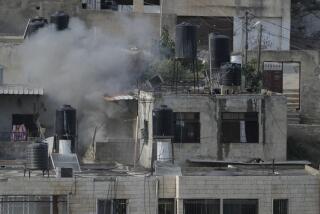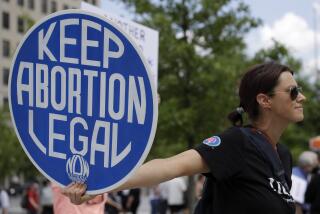County gets its first needle-exchange program
A year ago, a group of UC Irvine medical students realized that Orange County was missing what they considered an important public health service that every major city in California had access to — a clean-needle exchange program.
So they decided to do something about it.
The students organized with partners across the region and submitted a plan to the California Department of Public Health. The agency rejected it last summer, noting the lack of community support and funding for a program.
Undeterred, the group revised the plan, finding a location more amenable to local officials and raising money to support the venture. And last week, their work paid off. They won state approval to open Orange County’s first needle exchange.
The thinking behind such programs is that if drug use can’t be halted, at least harm can be reduced. Substituting clean needles for dirty ones means that users who inject face less exposure to diseases and infections.
The Orange County Needle Exchange Program opened Feb. 20 at the Santa Ana Civic Center in a mobile site behind City Hall.
“I’m from San Francisco, where needle exchanges are very common and widely acknowledged to be an important factor in stemming the HIV epidemic,” said Kyle Barbour, a founding member of the OCNEP and a second-year medical student. “So I was shocked to find that Orange County didn’t have one. We know that needle exchanges are safe, cheap and effective.”
The OCNEP’s original plan to house the exchange at an LGBT center in Santa Ana was initially met with resistance by local police and residents.
“We thought from a public safety standpoint that the first location was problematic,” said Santa Ana police Chief Carlos Rojas. “It was in a neighborhood with schools and a house of worship and looked like it would have led to more calls for service.”
So the OCNEP worked with the Santa Ana Police Department and other community groups to find a location everyone could agree on.
The Santa Ana Civic Center, Rojas explained, made the most sense.
“It’s away from residential areas,” he said. “We have a large homeless population there and a high concentration of IV drug users, so we saw this area as being more beneficial not only for the people who will be using the service, but also from a public safety aspect.”
The organizers then took care of the immediate funding concerns by raising $100,000 — which will keep the exchange running for several years, they estimate — from groups including the California Medical Assn. Foundation and the Elizabeth Taylor AIDS Foundation.
Barbour said one of the biggest obstacles to the exchange has been fear.
“There’s been 40 years of research on needle exchanges, and not a single scientific study has demonstrated that there’s any harm either for public safety or public health,” he said. “But despite that, there’s a lot of fear of needle exchanges and injection drug users.”
“That fear often translates into a lack of political support. Our clients are injection drug users and sex workers —marginalized and largely oppressed populations. Their interests are by and large not heard, and as a consequence, elected officials feel that if they support those interests, they may suffer in the polls for it.”
The OCNEP provides clean needles — up to 20 more than the number turned in by a person — and also safe-injection supplies such as cookers, tourniquets and cotton; condoms and lubricant; and a list of community resources for services such as housing and healthcare. OCNEP is also working with community partners to provide on-site HIV and pregnancy testing.
The OCNEP, a volunteer-run nonprofit, now boasts a long list of community supporters, including the Orange County Medical Assn., the AIDS Service Foundation of Orange County and the LGBT Center OC.
While political support for needle exchanges is often tepid, medical research is not.
“There are clear, clear data in many neighborhoods and cities that show clean needles can help reduce the transmission of diseases such as HIV, Hepatitis B, Hepatitis C, and help reduce bacterial infections,” said Bharath Chakravarthy, research director in the emergency medicine department at UC Irvine.
The National Institutes of Health has said that needle exchanges can reduce the risk of HIV among injection drug users by at least 30%, and the Centers for Disease Control and Prevention has called the use of sterile needles the “safest, most effective approach for limiting HIV transmission” among injection drug users.
Chakravarthy, who serves as medical director for the OCNEP, also said that because of stigma, injection drug users are less likely to seek out traditional medical treatment, so needle exchanges often become the first point of care.
“Needle exchanges increase the likelihood of referring injection drug users to other treatment centers and getting them talking about quitting, giving them pharmacological alternatives or screening them for infectious diseases,” he said.
Nathan Birnbaum, a member of the OCNEP steering committee and a first-year medical student at UCI, explained that the group expects good results because, for one reason, they’ll treat all clients with dignity and respect.
“We’re never going to ask if you have health insurance, we’re not going to ask how much money you make,” he said. “You’re here because you’ve identified that this is a need of yours, and we’re here to provide it without judging or stigmatizing you.”
Alex Smith, a recovering heroin addict who now serves on the board of the OCNEP, can attest to the benefit of this approach.
The college graduate first tried heroin at age 22 and was eventually hospitalized after developing an infection from using dirty needles. She tried to buy clean supplies at a pharmacy but was turned away, so she went to a needle exchange program in Oxnard.
“When you’re a heroin addict, you live in the shadows,” said Smith. “It’s a demoralizing and demeaning world, and you think no one gives a .... But to have community members come forward and support IV drug users through a needle exchange shows that people care about you.”
She added: “It only takes one person to show you compassion, grace and dignity to save your life.”
The needle exchange was the first step in Smith’s road to recovery. She has been sober for nearly 2 1/2 years and works as an applied behavior analysis therapist.
The establishment of the OCNEP comes at a critical time, since heroin use is rising throughout the county.
“We’ve seen a tremendous uptick in the number of emergency room visits, overdoses and deaths from heroin,” said Chakravarthy. “Heroin use has gone up drastically throughout the country and Southern California. It’s extremely cheap, and in some places, it’s cheaper to buy heroin illegally than to get a hold of prescription opioid pills.”
Data from the 2013 National Survey on Drug Use and Health showed that heroin use nationwide increased 79% between 2007 and 2012.
In Orange County, 69 people died from heroin-related causes in 2014, up from 51 deaths in 2013 and 42 in 2012, according to the coroner’s office.
“Back in the 1970s and 1980s, heroin was thought of as a dirty drug that was affiliated with folks who were disenfranchised and on the streets,” said Chakravarthy. “That is no longer the case. This has no boundaries in terms of demographics. Especially now, it has really hit our affluent neighborhoods as well as our disenfranchised neighborhoods.”
Barbour hopes the opening of the OCNEP signals a broader change.
“We feel the approval of the Orange County Needle Exchange Program epitomizes Orange County gradually coming into the modern era,” he said, “so that whether you’re poor, stigmatized, minority or majority, you have access to the basic healthcare services that everyone deserves.”
The needle exchange will be available from noon to 3 p.m. Saturdays at 20 Civic Center Plaza, Santa Ana.
More to Read
Sign up for Essential California
The most important California stories and recommendations in your inbox every morning.
You may occasionally receive promotional content from the Los Angeles Times.










